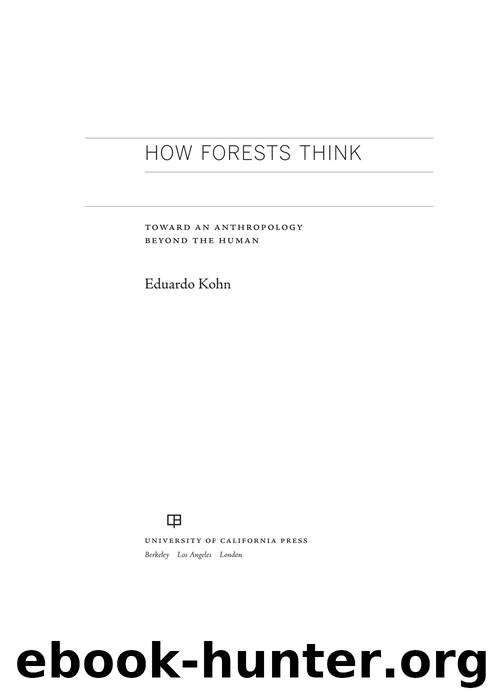How Forests Think by Kohn Eduardo;

Author:Kohn, Eduardo;
Language: eng
Format: epub
Publisher: University of California Press
ALL TOO HUMAN
The ecology of selves within which the Runa, their dogs, and the many beings of the forest live reaches well beyond the human, but it is also one that is “all too human.”2 I use this term to refer to the ways in which our lives and those of others get caught up in the moral webs we humans spin. I wish to signal that an anthropology that seeks a more capacious understanding of the human by attending to our relations to those who stand beyond us must also understand such relations by virtue of the ways in which they can be affected by that which is distinctively human.
I argued in chapter 1 that symbolic reference is distinctively human. That is, the symbolic is something that is (on this planet) unique to humans. The moral is also distinctively human, because to think morally and to act ethically requires symbolic reference. It requires the ability to momentarily distance ourselves from the world and our actions in it to reflect on our possible modes of future conduct—conduct that we can deem potentially good for others that are not us. This distancing is achieved through symbolic reference.
My intention here is not to arrive at a universal understanding of what might be an appropriate moral system. Nor is it a claim that living well with others—what Haraway (2008: 288–89) calls “flourishing”—necessarily requires rational abstraction, or morality (even though thinking about the good does). But to imagine an anthropology beyond the human that does not simply project human qualities everywhere we must situate morality ontologically. That is, we must be precise about where and when morality comes to exist. To state it baldly, before humans walked this earth there was no morality and no ethics. Morality is not constitutive of the nonhuman beings with whom we share this planet. It is potentially appropriate to morally evaluate actions we humans initiate. This is not the case for nonhumans (see Deacon 1997: 219).
Value, by contrast, is intrinsic to the broader nonhuman living world because it is intrinsic to life. There are things that are good or bad for a living self and its potential for growth (see Deacon 2012: 25, 322), keeping in mind that by “growth” I mean the possibility to learn by experience (see chapter 2). Because nonhuman living selves can grow it is appropriate to think about the moral implications our actions have on their potential to grow well—to flourish.3
As with the symbolic, to say that the moral is distinctive does not mean that it is cut off from that from which it emerges. Morality stands in a relation of emergent continuity to value, just as symbolic reference stands in a relation of emergent continuity to indexical reference. And value extends beyond the human. It is a constitutive feature of living selves. Our moral worlds can affect nonhuman beings precisely because there are things that are good or bad for them. And some of those things that are good or bad for
Download
This site does not store any files on its server. We only index and link to content provided by other sites. Please contact the content providers to delete copyright contents if any and email us, we'll remove relevant links or contents immediately.
Man-made Catastrophes and Risk Information Concealment by Dmitry Chernov & Didier Sornette(5921)
The Revenge of Geography: What the Map Tells Us About Coming Conflicts and the Battle Against Fate by Kaplan Robert D(4035)
Zero Waste Home by Bea Johnson(3777)
COSMOS by Carl Sagan(3554)
Good by S. Walden(3485)
In a Sunburned Country by Bill Bryson(3481)
The Fate of Rome: Climate, Disease, and the End of an Empire (The Princeton History of the Ancient World) by Kyle Harper(3003)
A Wilder Time by William E. Glassley(2818)
Camino Island by John Grisham(2762)
The Ogre by Doug Scott(2631)
Organic Mushroom Farming and Mycoremediation by Tradd Cotter(2626)
Human Dynamics Research in Smart and Connected Communities by Shih-Lung Shaw & Daniel Sui(2465)
Energy Myths and Realities by Vaclav Smil(2438)
The Traveler's Gift by Andy Andrews(2409)
9781803241661-PYTHON FOR ARCGIS PRO by Unknown(2321)
Inside the Middle East by Avi Melamed(2305)
Birds of New Guinea by Pratt Thane K.; Beehler Bruce M.; Anderton John C(2224)
A History of Warfare by John Keegan(2186)
And the Band Played On by Randy Shilts(2129)
